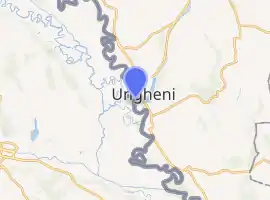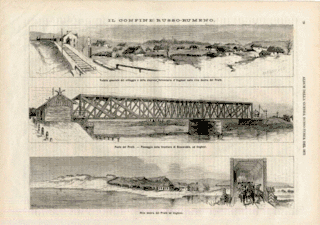Eiffel Bridge, Ungheni
The Eiffel Bridge (Romanian: Podul Eiffel) is a bridge over the River Prut and a checkpoint between Moldova and Romania. The bridge is located between Ungheni, Moldova and Ungheni, Romania.
Eiffel Bridge | |
|---|---|
 | |
| Coordinates | 47°11′59.6″N 27°47′13.5″E |
| Crosses | Prut |
| Locale | between Ungheni and Ungheni, Iași |
| Preceded by | A bridge built in 1874 |
| History | |
| Designer | Gustave Eiffel |
| Opened | April 21 [O.S. April 9] 1877 |
| Location | |

| |
History
On May 18 [O.S. May 6] 1872 a Russian diplomatic agent, Ivan Alekseevich Zinov'ev, and Gheorghe Costaforu signed a rail junction convention, which was ratified on January 21 [O.S. January 9] 1873.[1] and the Iaşi-Ungheni railway was opened on August 1, 1874. The railway Chişinău-Corneşti-Ungheni (built 1871–1875) was opened on June 1, 1875 by the Russian Empire in preparation for the Russo-Turkish War (1877–1878). Ungheni customs were established in 1875 after putting into operation the Chişinău-Ungheni-Iaşi railroad. The railway Chişinău-Corneşti was already opened in 1873.
In 1876, after the spring flooding of the river Prut, the railway bridge that linked Bessarabia and Romania was almost destroyed. The Railway Department invited Gustave Eiffel to Bessarabia (Moldova) to redesign and rebuild the bridge, which was opened on April 21 [O.S. April 9] 1877, just three days before the outbreak of the Russo-Turkish War (1877–1878). On April 23 [O.S. April 11] 1877, Russian troops entered Romania at Ungheni and, the next day, Russia declared war on the Ottoman Empire. Today, the bridge remains a strategically positioned construction under the supervision of border guards.
In the nearby city of Iaşi, Gustave Eiffel also built the Grand Hotel Traian (1882).
Gallery

 The bridge in 2010
The bridge in 2010 Panoramic photograph of the bridge in 2016
Panoramic photograph of the bridge in 2016 A distance look on the bridge
A distance look on the bridge
See also
- Moldovan–Romanian relations
- List of bridges in Moldova
- List of bridges in Romania
Notes
- Frederick Kellogg, The Road to Romanian Independence, 1995, p. 84
External links
- Customs Service of the Republic of Moldova
- (in Romanian) Caile Ferate Moldovene, la rascruce de drumuri
- (in Romanian) [ Tripla semnificaţie a zilei de 9 Mai]